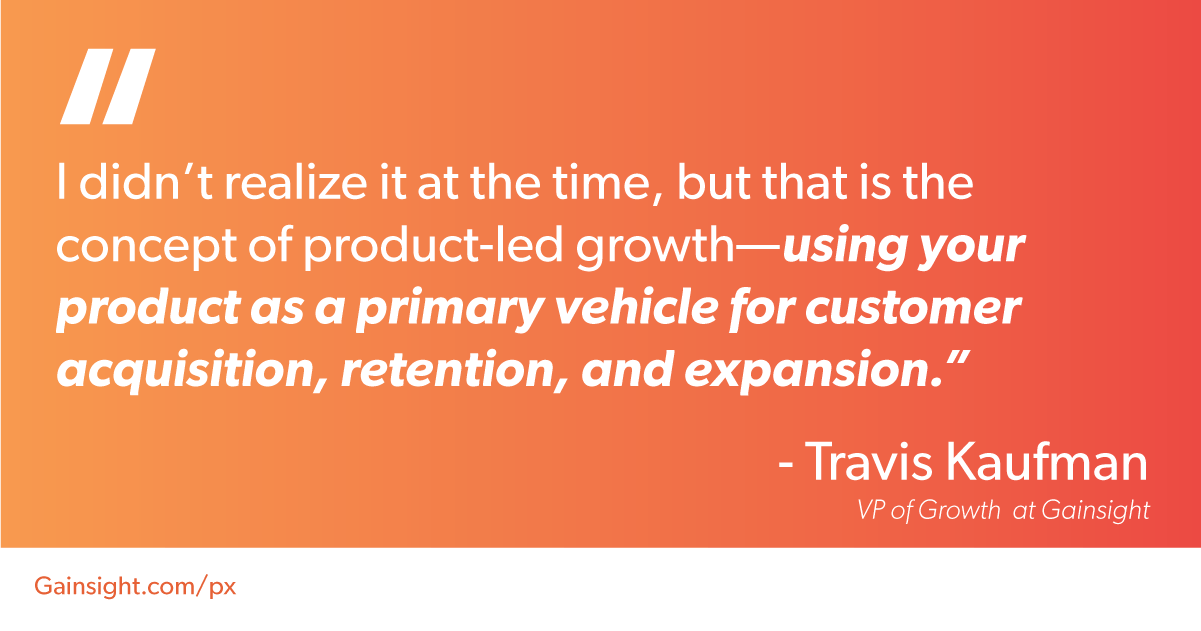What is product-led growth, exactly? Travis Kaufman, VP of Product Growth at Gainsight, defines the buzzword and shares growth-boosting best practices.
This Q&A is an excerpt from our webinar, Ask an Expert Q&A: How to Build Products That Drive Growth. You can listen to Travis and Gainsight’s VP of Product, Ciara Peter, share their expertise in full here.
Long gone are the days when sales-led or marketing-led growth reigned supreme. Now, 80% of consumers prefer to do business with a company that offers personalization, making product experience intimacy vital to growth. Product-led growth uses this intimacy to drive user acquisition, expansion, and retention from the product itself. The result? A superior user experience. Let’s take a look at some tips to create your own product-led growth strategy.
Catch Travis onstage at Product Marketing Summit in San Francisco where he’ll continue the discussion on product-led growth.
Q: What qualities should a product team that is focused on driving growth possess?
Travis: Historically, we would create enterprise software, enable our go-to-market team, and the product itself was treated like a good you would pick up off the shelf and hand to someone else to use.
The challenge we faced was that we ended up with a false sense of success. Customers would listen to the value propositions our marketing and sales team were saying, sign on the dotted line without using the product, then have a massive expectation gap on what they were purchasing versus what they received. This led to challenges on the post-sale side of customer success.
What I was looking for was to flip the expectation gap around and get my product into the hands of my customers in order for them to realize value as a result of using the product, not just on what people were saying.
I didn’t realize it at the time but that is the concept of product-led growth—using your product as a primary vehicle for customer acquisition, retention, and expansion.

Look at companies who have a free trial. That’s a vehicle for the customer to interact with a product and try it before they buy it.
With that in mind, I would say teams or product leaders that are executing a product-led go-to-market strategy should have a strong emphasis on and empathy for the user—not just the buyer. How are they interacting with the product? What is their experience like? Are there areas of friction?
I also find that there’s a great deal of experimentation. It’s not a matter of defining requirements upfront or working with engineers. It is actually a more iterative type process around experimentation. You’re looking at information, you’re very results-oriented, you’re introducing new tests to assume that you can influence your users’ behavior in a positive way to achieve a specific business outcome.
What is the “aha moment” that my user is going to receive that is going to help them move forward in the purchase process with our company as opposed to the thousands of others that are out there?
So those are three things that shape up empathy for the user and the buyer: being very data-driven, being very experimentation driven, and both of those focal points leading towards a specific outcome.
Q: What sort of challenges have you experienced convincing executives to adopt a growth mindset?
Travis: There is a lot of fear of, “If I’m going to give someone access to my product, how are they going to understand the value if I don’t speak with them?”
You have to overcome that fear in a number of ways and gradually step into it. That is one of the challenges—not only do you have to convince execs, but if you have a sales-led organization, there are going to be reps that feel as though you’re taking opportunities from them.
One of the ways to overcome that is to be very clear and have an understanding of the role change that your sales team will have and when it is appropriate for them to engage with someone who is trying your product. Getting over that fear is definitely something you have to overcome for an organization that’s primarily sales-led in their go-to-market motion.
Q: What Gainsight PX features, strategies, and tactics can help a company be more growth-driven?
Travis: I am a customer and a user of our own offering. Visibility into where you should be spending your time experimenting is a table stakes growth exercise and Gainsight PX gives me that visibility.
Second, there’s a challenge around using analytics to understand where you should focus but it doesn’t always tell you what the potential solutions could be. We actually run a set of qualitative surveys out to those users in that particular stage of the product to understand what their challenges are.
We start with a hypothesis. Then, we go out and try to validate that hypothesis just like any other product person would do. Gainsight PX gives me that flexibility to reach out to very specific users and get feedback from them.
Lastly, there are a number of tools I can use within Gainsight PX to help guide users to understand and use our capability, so I’m actually freeing up a lot of our team’s time that would otherwise be spent being consumed by some of the experimentation work.
Those are the three ways that I’m currently using Gainsight PX for as far as product growth-type activities, but there are other aspects too. One of the common misconceptions about product growth, or even product-led growth strategies, is that there are no people behind the scenes you need to work with.
Actually, in many cases, there is a product-assisted approach to where I can help our customers renew more effectively by making sure that our account team has visibility into what customers are doing in the product. So, that’s something that Gainsight PX can help with as well.
If you are a product leader in an enterprise SaaS company and your customer-facing teams are flying blind around what customers are doing in your product, this gives them that visibility. That’s a good quick win for you to help them understand what the key features are that correlate to retention. That’s going to help your success team, that’s going to help your renewal rate, and that’s ultimately a success measure of your product.
Q: What is the biggest myth about product growth?
Travis: I mentioned earlier an example that it’s replacing the people in an organization. That’s one myth. The other is that product-led strategy is only for products that have a low price point or potentially low consideration purchases.
Look at Google Cloud Platform and the millions of dollars organizations are spending to host their offerings. It’s a very considered purchase that you can make without speaking to anyone.
3 Lessons for Product-Led Growth
Lesson #1: Product-led growth focuses on empathy for the customer
Companies can’t just create products and expect them to sell anymore. Product-led growth instead focuses on these three things:
- Using the product as a vehicle for acquisition, retention, and expansion
- Understanding how customers are using their product and what they are using it for
- Experimenting with the product to make data-driven decisions
Lesson #2: Experimentation is key to growth
It’s risky to not take risks. Product managers in growth roles should focus on experimenting where they can, as long as it doesn’t interrupt the customer workflow. By starting small and tracking ROI, companies can become more comfortable with experimentation and begin optimizing for more successful features and functions.
Lesson #3: Understanding your analytics guides the way for growth
The product roadmap is growing increasingly complex and it’s difficult to maintain a real-time view of accurate user analytics. Incorporating a product management platform into your company helps both the product team and customer-facing teams gain visibility into valuable analytics that can then be used to better understand user sentiment.
Going to Product Marketing Summit? Don’t forget to catch Travis’ session on product-led growth on September 18, at 2:35 p.m. and check out the Gainsight PX booth!
![3 Lessons I Learned About Product-Led Growth [Interview] Image](https://www.gainsight.com/wp-content/uploads/2019/09/3-lessons-I-learned-about-product-led-growth.png)
